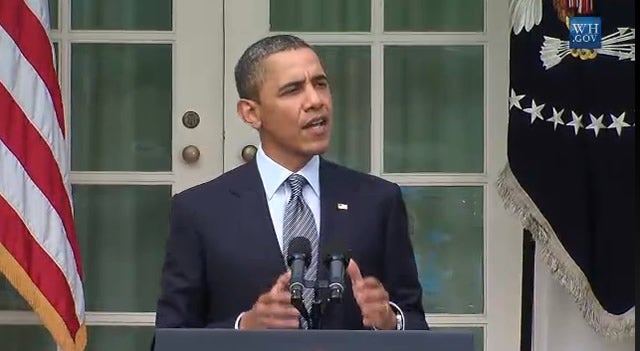During his Rose Garden speech Monday, the President claimed that his new “debt reduction” plan would provide $2 of spending cuts for every $1 of tax increases. A closer look at the administration’s own numbers, however, suggests the President, well, exaggerated.
A realistic assessment—based mainly on table S-6 of the Administration’s plan—shows that his $1.57 trillion in tax increases are accompanied by just $130 billion in net new, policy-based spending reductions.
The President’s “plan” claims credit for the following:
Policies Already Enacted. The debt reduction proposal starts with two items already in place: reductions from the full-year continuing resolution for fiscal year 2011 ($357 billion over 10 years) and savings from the discretionary spending caps in the Budget Control Act ($992 billion).
The Administration does concede that these reductions already have been enacted—sort of. Except when the President contends that his “plan” would reduce deficits by more than $4 trillion, as he did Monday; he includes these existing reductions, in effect double-counting them (as he did with the $500 billion in Medicare savings for Obamacare).
It should also be noted that these policies yield “savings” only because they are measured against an illusory “baseline” that assumes that all discretionary spending programs will continue into the future intact, with increases to account for inflation. As long as spending does not increase as much as the baseline, it is considered a reduction.
For instance, if the baseline projects spending to rise by $1.5 trillion in the next 10 years and Congress increases it “only” $1.25 trillion, it’s considered a $250 billion “reduction,” even though spending has increased by more than $1 trillion. This baseline measurement is a Washington practice so entrenched it is usually taken for granted. Bottom line: These savings should not be counted as new spending cuts.
Bogus War Savings. The President then plays an even bolder baseline game, claiming $1.084 trillion in spending reductions from winding down military operations in Iraq and Afghanistan. Once again, these “savings” occur only because the Administration baseline for war spending (termed “overseas contingency operations”) starts with the 2010 “surge” level spending and then rises with inflation over the next 10 years—a policy that no one really assumes will happen.
Compared with this unreal baseline, the President’s proposed war spending—$126.5 billion for fiscal year 2012, and then placeholders of $50 billion a year through 2021—results in more than $1 trillion in “savings.” Hardly anyone in the federal budget game accepts these as legitimate spending reductions—except, of course, the President.
Debt Service. Curiously, the second-largest new spending reduction in the President’s plan—and the largest mandatory spending reduction—is a reduction in interest payments ($715 billion). This is not a policy change; it is simply the result of the assumed deficit reduction. Deficit reduction plans should be evaluated on the basis of real policy choices and should not take credit for such secondary effects.
Mandatory and Health Savings. The plan does list a number of entitlement policies that, if enacted, might actually reduce spending. The value and likelihood of these proposals are discussed in yesterday’s Heritage blog. The estimated savings are about $577 billion over 10 years.
New Stimulus Proposals. Ironically, the net new spending reductions in the President’s plan almost equal the amount of deficit increases from his “jobs” proposal introduced last week: All but $130 billion of the President’s net new policy-based spending reductions are swallowed up by the stimulus.
One of the best measures of the size and scope of government is spending, because every dollar of government spending is financed through taxes, borrowing, fees, premiums, etc., and all drain resources from the economy. Ultimately, the President’s “debt reduction” proposals do nothing to reduce net spending. It simply reflects the audacity of big government: keep spending high and drive taxes higher.

